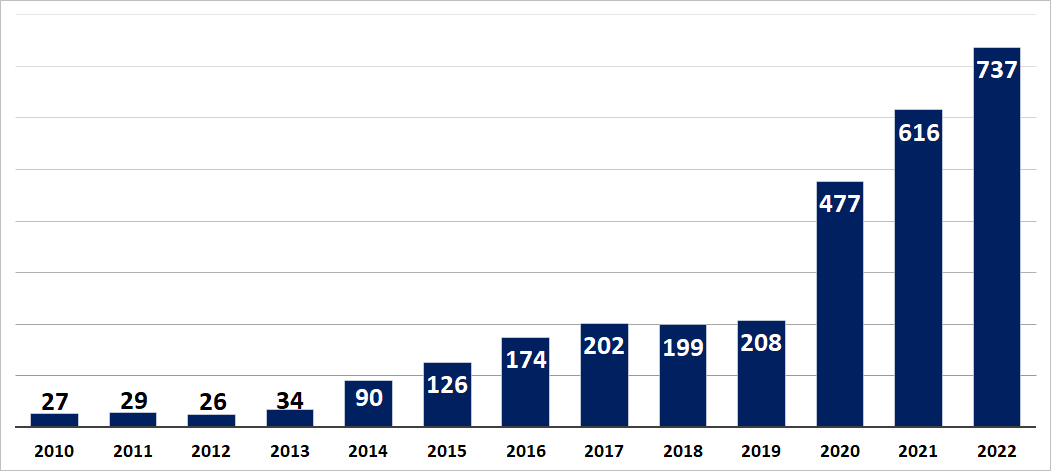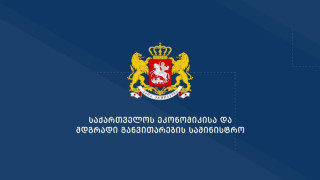Ministry of Economy and Sustainable Development: “In 2017-2022, export to China increased by 265% and the export structure also expanded.”
Verdict: FactCheck concludes that the statement of the Ministry of Economy and Sustainable Development is MOSTLY TRUE.
Since January 2018, a free trade agreement between Georgia and China has been in effect. After the agreement started, export to China increased by 265% from USD 202 million to USD 736 million in 2017-2022.
In 2017, there were 51 product groups exported to China with the value of six of the products exceeding USD 1 million. In 2022, these groups of exported good rose to 107 with 12 of them being worth more than USD 1 million.
Although there is a clear growth in the reporting period, export to China was also increasing before 2018. In 2009, Georgia exported products to China worth of USD 6 million. The total export value was USD 34 million in 2013 and the export figure amounted to USD 202 million in 2017 before the free trade agreement went into effect.
Given the accuracy of figures provided, although disregarding the full context, FactCheck concludes that the statement released by the Ministry of Economy and Sustainable Development is MOSTLY TRUE.
Analysis:
The Ministry of Economy and Sustainable Development published a press release in regard to Minister Levan Davitashvili’s visit to China, emphasising the increased export to China after the free trade agreement went into effect: “The meeting focused on the development of trade and economic relations with China after the Free Trade Agreement between the two countries came into effect. It was noted that give years after its entry into force, the trade statistics between China and Georgia have changed significantly. In particular, in 2022, as compared to 2017, the trade turnover was increased by 94% and the exports – by 265% amounting to USD 736.9 million. The structure of exports also changed significantly and new export products from Georgia appeared on the Chinese consumer market. At the same time, the Minister emphasised the fact that the agreement can bring more benefits to both countries.”
The Georgia-China free trade agreement came into effect in January 2018. As of 2017, trade turnover between the two countries amounted to USD 934 million (USD 202 million export and USD 732 million import). In 2022, the volume of trade turnover increased by 98% and reached nearly USD 1.9 billion (USD 737 million export and USD 1.126 billion export). Both in 2017 and 2022, China was ranked third among Georgia’s top trade partners after Turkey and Russia, although Beijing’s share increased only slightly from 8.8% to 9.8%.
Graph 1: Export to China (USD Million)

Source: National Statistics Office of Georgia
The free trade agreement exempted both sides from customs duties, yet exports increased by 265% and imports by only 53%, reducing the trade deficit from 57% to 21%.
Along with the total export, the list of export products also increased during the reporting period. In particular, if in 2017 a total of 51 types of products were exported, the list increased to 107 in 2022. The number of products whose export value exceeded USD 1 million annually has also doubled (from six to 12).
The figures in the statement released by the Ministry is completely true but this statement taken separately creates a false impression that the increase in exports is attributable only to the free trade agreement. Exports were growing in the previous period as well and in some cases, at a faster rate.
In 1995-2009, a total of USD 50 million worth of products were exported to China which amounted to 0.56% of the total exports. In 2010, exports increased 4.5 times - from USD 6 million to USD 27 million whilst the growth dynamic persisted in the subsequent period and reached USD 202 million in 2017.
In 2023, the growth dynamic changed into a decline. In January-September, exports to China decreased by 54% from USD 575 million to USD 267 million dollars as compared to the same period of the previous year. If in 2020-2022 China was Georgia’s top export partner, it moved to the seventh position in 2023.
Graph 2: Export to China (USD Million)
 Source: National Statistics Office of Georgia
Source: National Statistics Office of Georgia
The main reason why exports to China dropped was the decline in the price and demand for copper ores. In January-September 2022, USD 452 million worth of copper ores were sold in China which is 62% less as compared to the same period of 2023 – USD 162 million. In the first three quarters of last year, a total of 189,000 tonnes of ore were exported with the figure halving to 94,000 tonnes this year. On average, the export price per tonne has decreased by 24% from USD 2,395 to USD 1,764
Although the list of export products to China has doubled, the share of copper ores has virtually not changed. In 2017 it was equal to 81%, in 2022 it was 79% and it decreased to 64% in January-September 2023.
In addition to copper ores, the export value of other precious metals also decreased from USD 64 million to USD 45 million. Small changes in the rest of the products did not have a significant impact on the total export.
As of January-September 2023, China’s share in Georgia’s total export was 5.8% which is less as compared to what it was in 2016 and 2017; that is, in the period when the free trade agreement was not in effect.
In addition to the drop in monetary value, China's share in Georgia’s exports decreased largely because of increased export to other countries, mostly at the expense of re-exports.
Ultimately, all figures in the statement released by the Ministry are accurate:
1) In 2017-2022, the trade turnover with China doubled.
2) Exports taken separately increased by 265%.
3) The structure of export was expanded.
It is an entirely different issue that 2017-2022 is but one period of the full picture. Export growth is not only attributable to the free trade agreement and, for reasons unrelated to the government (Georgia cannot determine global supply and price on copper ores), Georgia’s export to China halved in 2023 which seems contradictory to the spirit of deepening relations and ties evolving into a strategic partnership format. Therefore, due to the accuracy in terms of figures, although failing to take the full context into account, FactCheck concludes that the statement released by the Ministry of Economy is MOSTLY TRUE.








